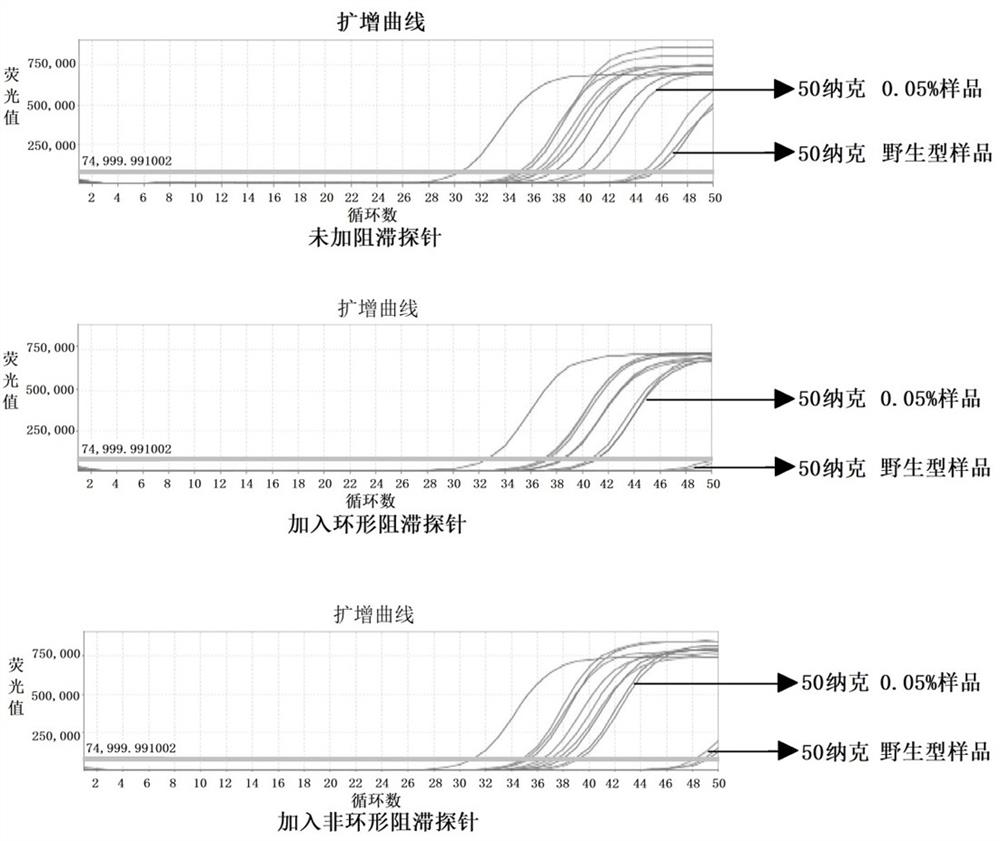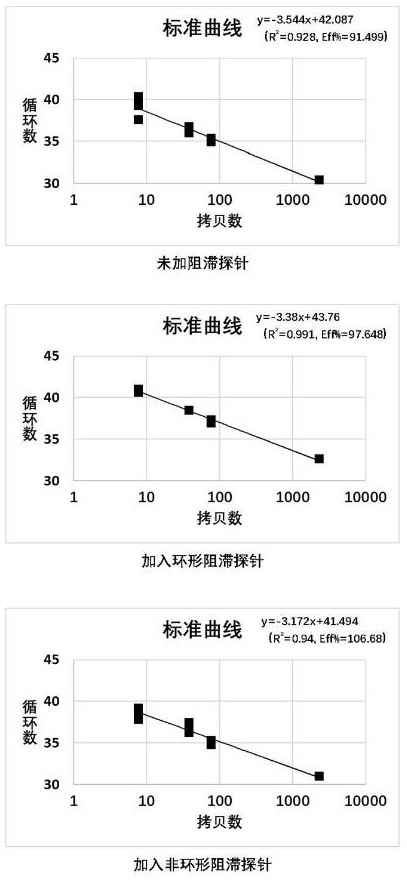A circular blocking probe, an amplification hindering mutation system containing the circular blocking probe and its application
A technology for amplifying impeding mutations and probes, which can be used in the determination/inspection of microorganisms, biochemical equipment and methods, DNA/RNA fragments, etc., and can solve problems such as the inability to significantly improve linear performance and the inability to effectively reduce non-specific amplification. , to avoid non-specific amplification, improve amplification specificity and linear range, and reduce non-specific amplification
- Summary
- Abstract
- Description
- Claims
- Application Information
AI Technical Summary
Problems solved by technology
Method used
Image
Examples
Embodiment 1
[0054] Example 1 Detection Principle of the Amplification-Hindered Mutation System Containing a Circular Blocking Probe
[0055] The blocking principle of the circular blocking probe is as follows: figure 1 As shown, under non-denaturing conditions, the first binding sequence and the second binding sequence of the circular blocking probe complement each other to form a circular structure, which does not bind to the template, which reduces the interference to the PCR reaction to a certain extent; Under these conditions, the first binding sequence and the second binding sequence of the circular blocking probe melt, and the circular structure opens, and the blocking probe specifically binds to the wild-type site corresponding to the point mutation and its downstream, preventing the wild-type template from forming. Amplify.
[0056] The detection principle of the fluorescent quantitative amplification hindered mutation system containing the above-mentioned circular blocking probe...
Embodiment 2
[0057] Example 2 Quantitative detection of JAK2-1849G / T mutation
[0058] In this example, using human JAK2 genomic DNA (NCBI: NG_009904.1) as a template, PCR primer pairs, fluorescent probes and circular blocking probes were designed for the 1849G / T mutation site.
[0059] Among them, the 3' end of the specific downstream primer is located at the mutation site and is complementary to the mutant type (T). Considering that the 3' end of the downstream primer and the wild-type template are strongly A / G mismatched, the 3' end of the downstream primer is strongly mismatched with the wild-type template. The penultimate position of the ' end introduces a weak A / C mismatch; the 3' end of the circular blocker probe is located at the mutation site and is complementary to the wild type (G), considering that the 3' end of the circular blocker probe is compatible with If the mutant template is a strong C / T mismatch, a weak A / C mismatch is introduced at the penultimate third position of th...
Embodiment 3
[0077] Embodiment 3 result analysis
[0078] The fluorescent quantitative PCR curve of the experimental results is as follows: figure 2 As shown, compared with the reaction system without adding the blocking probe, the wild-type non-specific amplification was significantly reduced after adding the blocking probe; while the specificity of the reaction system adding the circular blocking probe was better than that adding Reaction system for non-circular retardation probes. In addition, from the amplification curve, after adding the circular blocking probe, the repeatability of the low-frequency samples is good, and the amplification curves of samples with different frequencies are significantly different, indicating that the variance of the Ct value is small and the detection results are more accurate.
[0079] The standard curve of the experimental results is as image 3 As shown, when the mutation frequency of the sample is as low as 0.05%, the linearity of the standard cur...
PUM
 Login to View More
Login to View More Abstract
Description
Claims
Application Information
 Login to View More
Login to View More - R&D
- Intellectual Property
- Life Sciences
- Materials
- Tech Scout
- Unparalleled Data Quality
- Higher Quality Content
- 60% Fewer Hallucinations
Browse by: Latest US Patents, China's latest patents, Technical Efficacy Thesaurus, Application Domain, Technology Topic, Popular Technical Reports.
© 2025 PatSnap. All rights reserved.Legal|Privacy policy|Modern Slavery Act Transparency Statement|Sitemap|About US| Contact US: help@patsnap.com



